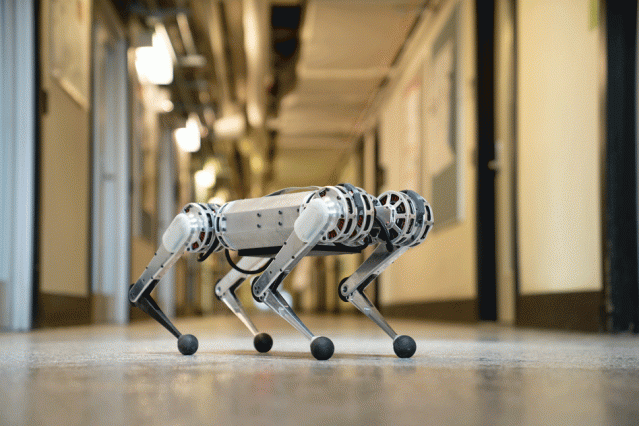Engineers at MIT have created a mini cheetah robot that can perform some impressive gymnastic-like maneuvers, including a 360-degree backflip from a standing position.
The four-legged, 20-pound robot can walk upside down and traverse uneven terrain twice as fast as a human’s walking speed. And if it falls over, it can swiftly get back on its feet. The mini cheetah has a large range of motion and can rotate its limbs and joints into yoga-like positions without losing balance.
Described as “virtually indestructible,” the robot is powered by electric motors used in drones and remote-controlled airplanes that are simple to replace. And the parts got together “almost like Legos,” notes lead developer Benjamin Katz, a technical associate in MIT’s Department of Mechanical Engineering.
The researchers built the mini cheetah for experimentation purposes. It has two very attractive qualities: it’s very durable and not expensive to fix if it breaks.
The team aims to build 10 robots and loan them out to other research labs so they can analyze various algorithms and maneuvers on a highly dynamic robot. They hope fellow engineers can use the robots to swap ideas and even invent their own machines.
“Eventually, I’m hoping we could have a robotic dog race through an obstacle course, where each team controls a mini cheetah with different algorithms, and we can see which strategy is more effective,” Sangbae Kim, associate professor of mechanical engineering explained. “That’s how you accelerate research.”
The mini cheetah is quite a bit different than its predecessor, Cheetah 3, which is much heavier and larger and requires stabilizers to protect its pricey, custom-made components. The mini cheetah doesn’t necessitate a redesign if you want to add another arm, for example. Its current design enables it to perform some dynamic maneuvers.
“When it’s running, its feet are only on the ground for something like 150 milliseconds at a time, during which a computer tells it to increase the force on the foot, then change it to balance, and then decrease that force really fast to lift up,” Katz explains. “So, it can do really dynamic stuff, like jump in the air with every step, or run with two feet on the ground at a time. Most robots aren’t capable of doing this, so move much slower.”
Katz and Jared Di Carlo, an undergraduate in the Department of Electrical Engineering and Computer Science (EECS), were inspired by a class they took with EECS Professor Russ Tedrake and decided to program the mini cheetah to perform a backflip.
It’s an impressive feat due to the power, torque, and huge impacts that the action requires. The Cheetah 3 would never be able to accomplish such a task.
The researchers are also working on another advanced maneuver—throwing the robot and having it lands on its feet. “Say you wanted to throw the robot into the window of a building and have it go explore inside the building. You could do that,” Kath notes.
Check out the mini cheetah in action HERE.


